1926
As directors, Wilhelm Güldenhaupt, Friedrich Wilhelm Zassenhaus senior and Friedrich Wilhelm Zassenhaus junior establish the “Felsenfest Westfälische Kalk- und Zementwerke” in Erwitte. Twenty-two years later, the company is acquired and managed by Josef Spenner, who originated from Büren.
 The brothers Josef and Heinrich Spenner, along with building contractor Ferdinand Pauly, the father-in-law of Josef Spenner, establish the “Nordstern” cement works for natural cement, in Erwitte. The planned output of the cement works is approx. 40 to 50 t per day.
The brothers Josef and Heinrich Spenner, along with building contractor Ferdinand Pauly, the father-in-law of Josef Spenner, establish the “Nordstern” cement works for natural cement, in Erwitte. The planned output of the cement works is approx. 40 to 50 t per day.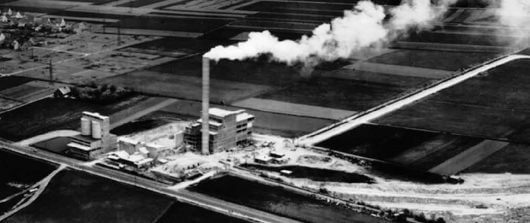 By notarial deed, Mr and Mrs Güldenhaupt, together with Friedrich Wilhelm Zassenhaus, transfer their shares in “Felsenfest” to Josef Spenner. The cement works was closed down during the Second World War. Damage caused during the war is rectified and the cement works recommences production. (Photos: FRN)
By notarial deed, Mr and Mrs Güldenhaupt, together with Friedrich Wilhelm Zassenhaus, transfer their shares in “Felsenfest” to Josef Spenner. The cement works was closed down during the Second World War. Damage caused during the war is rectified and the cement works recommences production. (Photos: FRN)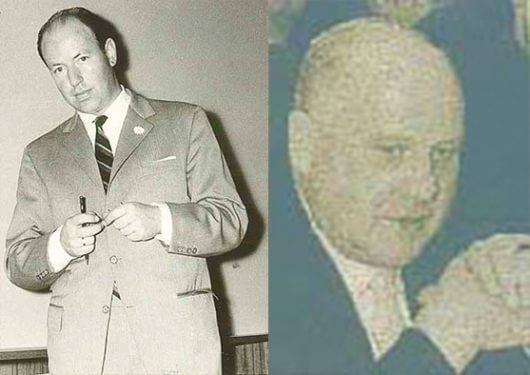 Dr Josef Heinrich Spenner, son of the company founder Josef Spenner, joins Nordstern as managing director next to director Hermann Michels.
Dr Josef Heinrich Spenner, son of the company founder Josef Spenner, joins Nordstern as managing director next to director Hermann Michels.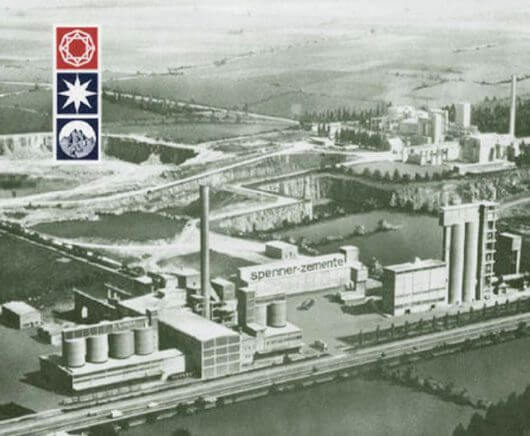 At the instigation of its “junior boss” Dr Josef Spenner, “Spenner Zement KG” starts building its first rotary tubular kiln in the “Diamant” section of the works. Production is carried out at the works using the heat-exchanger method, “almost completely dust-free” in comparison to the standards of the day. Spenner’s daily production now totals 700 t of rotary kiln clinkers.
At the instigation of its “junior boss” Dr Josef Spenner, “Spenner Zement KG” starts building its first rotary tubular kiln in the “Diamant” section of the works. Production is carried out at the works using the heat-exchanger method, “almost completely dust-free” in comparison to the standards of the day. Spenner’s daily production now totals 700 t of rotary kiln clinkers.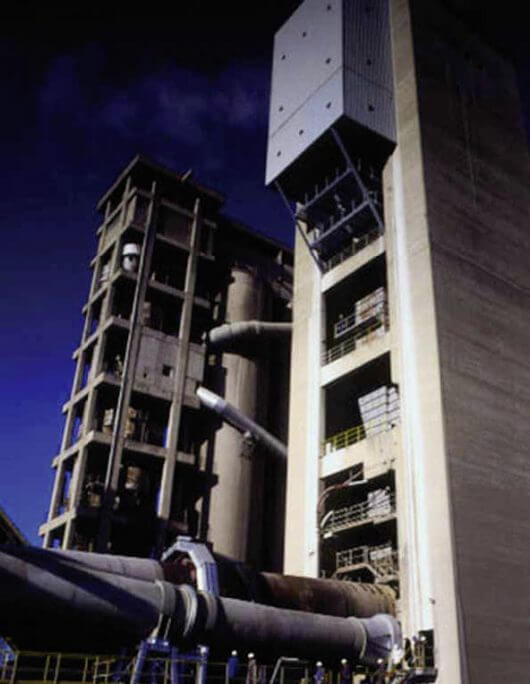 Spenner Zement commissions the second rotary kiln. It is the first “short rotary kiln” in the world, and causes an appropriate sensation amongst experts. Energy consumption of the second rotary kiln is approx. 3,400 MJ per ton of cement clinkers, with an authorised daily output of 2,500 t of clinkers.
Spenner Zement commissions the second rotary kiln. It is the first “short rotary kiln” in the world, and causes an appropriate sensation amongst experts. Energy consumption of the second rotary kiln is approx. 3,400 MJ per ton of cement clinkers, with an authorised daily output of 2,500 t of clinkers.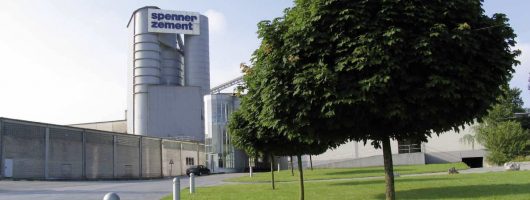 A dry mortar mixing system is added to the works in Erwitte. The works produce various types of mortar using several components. Mortars are dry-mixed building materials which only need to be mixed with water at the construction site.
A dry mortar mixing system is added to the works in Erwitte. The works produce various types of mortar using several components. Mortars are dry-mixed building materials which only need to be mixed with water at the construction site.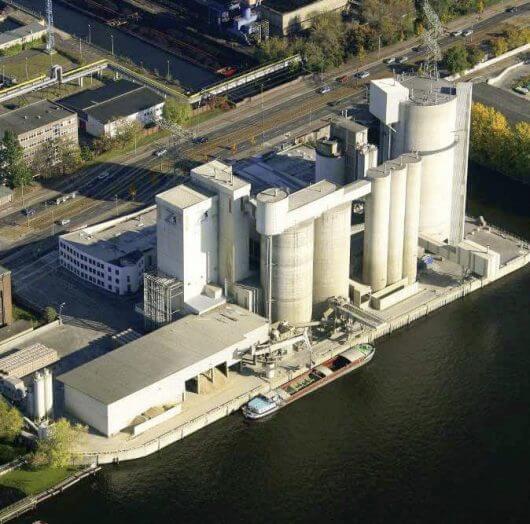 Spenner Zement GmbH & Co. KG, along with two medium-sized partners (Märker Zement GmbH and Portlandzementwerk Dotternhausen Rudolf Rohrbach KG), acquire the Rummelsburg cement works in Berlin, located directly on the River Spree, in a trust transaction. The works in the Lichtenberg suburb of Berlin had formerly been part of the Rüdersdorf/Dessau cement-producing collective. Since then, the milling plant has traded as Zementwerk Berlin GmbH & Co. KG. In 2004, Spenner Zement takes over the remaining shares in Zementwerk Berlin from the former co-owners.
Spenner Zement GmbH & Co. KG, along with two medium-sized partners (Märker Zement GmbH and Portlandzementwerk Dotternhausen Rudolf Rohrbach KG), acquire the Rummelsburg cement works in Berlin, located directly on the River Spree, in a trust transaction. The works in the Lichtenberg suburb of Berlin had formerly been part of the Rüdersdorf/Dessau cement-producing collective. Since then, the milling plant has traded as Zementwerk Berlin GmbH & Co. KG. In 2004, Spenner Zement takes over the remaining shares in Zementwerk Berlin from the former co-owners.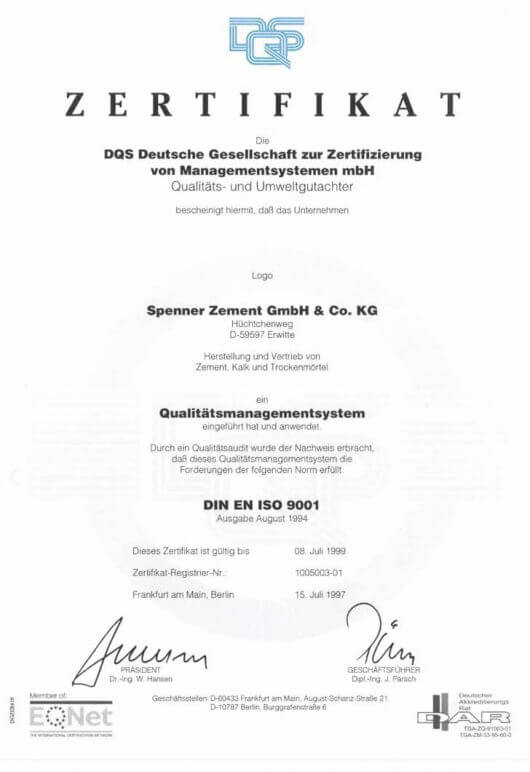 Spenner Zement is one of the first cement works to introduce a certified quality management system in accordance with DIN ISO 9001. During the next few years the company also introduces an environment management system in accordance with DIN ISO 14001 (in 2001), an industrial health and safety protection system in accordance with OHSAS 18001 (in 2005) and an energy management system in accordance with DIN ISO 50001 (in 2012).
Spenner Zement is one of the first cement works to introduce a certified quality management system in accordance with DIN ISO 9001. During the next few years the company also introduces an environment management system in accordance with DIN ISO 14001 (in 2001), an industrial health and safety protection system in accordance with OHSAS 18001 (in 2005) and an energy management system in accordance with DIN ISO 50001 (in 2012).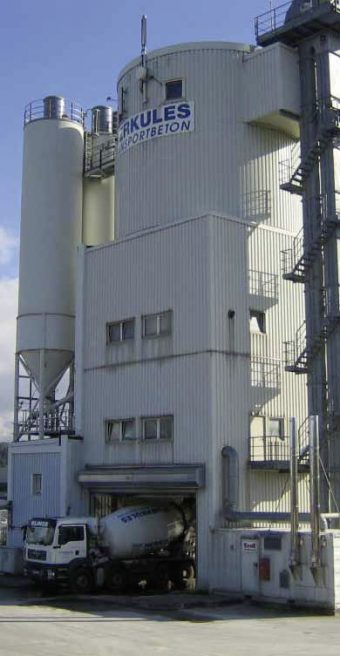 Spenner Zement enters the ready-mixed concrete business and builds its first ready-mixed concrete works in Kaufungen, near Kassel. The company trades under the name “Herkules Transportbeton GmbH & Co. KG”. In 1998, five ready-mixed concrete works in Essen, Duisburg, Dortmund, Münster and Siegen are acquired from HOCHTIEF. Between 1999 and 2011, 15 further ready-mixed concrete works are acquired in Central Hesse (Solms, Dillenburg, Buseck), in Lower Saxony (Braunschweig, Neindorf), in Rhineland (Leverkusen, Niederkassel), in Siegerland (Freudenberg), in Münsterland (Nottuln, Velen, Spelle, Rheine) and in East Westphalia (Schloß Holte, Lage, Paderborn). By 2011 Herkules is manufacturing at 21 different sites.
Spenner Zement enters the ready-mixed concrete business and builds its first ready-mixed concrete works in Kaufungen, near Kassel. The company trades under the name “Herkules Transportbeton GmbH & Co. KG”. In 1998, five ready-mixed concrete works in Essen, Duisburg, Dortmund, Münster and Siegen are acquired from HOCHTIEF. Between 1999 and 2011, 15 further ready-mixed concrete works are acquired in Central Hesse (Solms, Dillenburg, Buseck), in Lower Saxony (Braunschweig, Neindorf), in Rhineland (Leverkusen, Niederkassel), in Siegerland (Freudenberg), in Münsterland (Nottuln, Velen, Spelle, Rheine) and in East Westphalia (Schloß Holte, Lage, Paderborn). By 2011 Herkules is manufacturing at 21 different sites.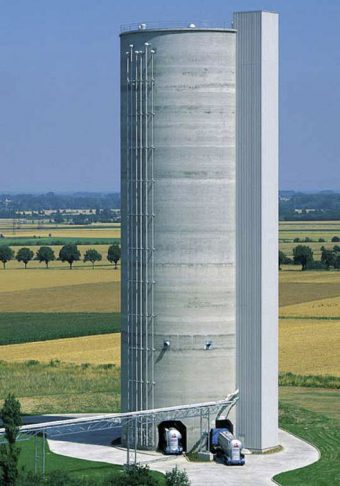 Official opening of the first multi-chamber blending silo in Erwitte to coincide with the company’s 75th anniversary. The silo is equipped with 16 silo chambers and uses a state-of-the-art mixing technique for the production of special cements consisting of several components.
Official opening of the first multi-chamber blending silo in Erwitte to coincide with the company’s 75th anniversary. The silo is equipped with 16 silo chambers and uses a state-of-the-art mixing technique for the production of special cements consisting of several components. Commissioning of the new limekiln 3, which works using the direct-current-countercurrent regenerative method. The results are very positive: 25% fuel savings compared to the former method, making it one of the most energy-efficient limekilns in Europe.
Commissioning of the new limekiln 3, which works using the direct-current-countercurrent regenerative method. The results are very positive: 25% fuel savings compared to the former method, making it one of the most energy-efficient limekilns in Europe.